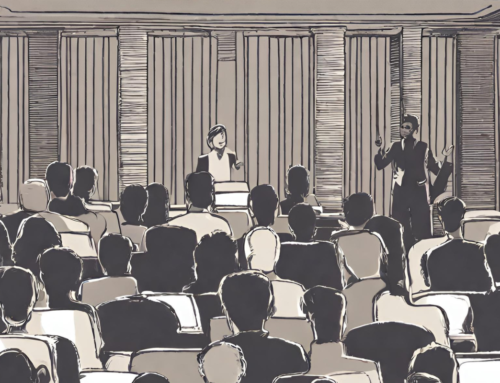Tamsen Webster is my favorite other speaking coach. I love how Tamsen’s work focuses on making the idea behind the speech the best it can be. It all begins with the idea. The only reason to give a speech is to change the world, and you change the world with the best possible ideas. The exciting news today is that Tamsen has written the book on her method, Find Your Red Thread, so that you can develop your own great speeches. Read on, get the book, and start improving those world-changing words!
Nick: I love the image of a Red Thread as a through line for an argument, speech, idea, and so on. Where does the Red Thread start — what should someone be looking for in order to get going?
Tamsen: The best place to start the story of your idea is where the action of any story starts: when we discover what someone wants…but doesn’t yet have. That engages our curiosity—we want to know what will happen! When an audience hears in a message something they want (but don’t yet have), not only will they get curious, they’ll likely stay curious until they hear how to get it. In that way, your idea is an—the answer—to a question your audience hasn’t yet answered successfully. So, the best way to find that thing they want is to brainstorm those questions your idea can answer. A word of warning here, though: make sure you’re brainstorming questions that your audience is actually asking, not the questions you wish they were asking (they’re likely not yet curious about those!).
Nick: So true, as I discovered when I published Can You Hear Me? in 2018! Few people were asking about making virtual communications better then. It wasn’t until the pandemic and March 2020 that interest in the book suddenly took off. OK, back to you! Can you always find a shared truth with the audience in order to create a good red-thread argument, or are those sometimes hard to come by?
Tamsen: Yes, you can always find that shared truth. In fact, if you don’t, you don’t have a solid case for your idea—or at least, you don’t have a solid case with that particular audience. As much as we’d like to think otherwise, our ideas aren’t for everyone. Long term, people simply will not accept an idea that violates their worldview or self-identity. That means any long-term change in thinking or behavior must align with those values and beliefs. And that means your job as a message maker is to find that shared belief. Is that easy? Often not—but not because they don’t exist. I find it’s more often because that shared truth is something so fundamental to how people see the world, it doesn’t occur to someone to articulate it out loud. But the articulation of that shared truth is the key to your audience identifying with your idea and truly feeling like it’s for them. If a shared truth truly doesn’t exist, then your idea isn’t for that audience, and it’s time to find a new audience (or a new idea).
Nick: Your background is in marketing, and one of the hardest things to do is to persuade people to buy a new product in a saturated market. That’s what makes the Red Thread so exciting — can you tell us how de Beers made it work for diamonds
Tamsen: The story De Beers told us all about diamonds is one of my favorites, mostly because we all know it, even if it hasn’t become a story we tell ourselves. The story (both the actual story and the story of the idea) starts back in the 1930s, when De Beers wanted to expand the retail market for their diamonds. At the time, engagement rings were fairly uncommon, and even when couples bought them any ring of value was a sufficient symbol, diamonds or not. After all, any ring was an unbroken circle, a perfectly fine symbol of “forever”! But De Beers seems to have realized that for couples who wanted the best symbol of their commitment, they had an opportunity to shift the perspective beyond the predominant circle-as-symbol thinking. Enter their famous tagline, “A diamond is forever.” It’s a great shared truth: most people would agree that a diamond is literally very hard to destroy. But in the context of wanting the best symbol of forever, that literal truth became metaphorical — De Beers turned the stone into a symbol of forever, and the trap…er…story was set. If you wanted the best symbol, you could have both a “forever” ring (the circle of metal) and a “forever” stone. Double forever! And diamond rings have been pretty much the dominant symbol of forever commitments ever since. (This story is also an example of how a story or idea isn’t for everyone: there are plenty of people for whom diamonds symbolize something far different—the dominance of heteronormative ideals of partnership, for example, or, with “blood” or “conflict” diamonds, the suppression of human rights. In those cases, the story doesn’t work.)
Nick: Do you have a favorite speech or speeches that exemplify your approach?
Tamsen: That’s like choosing between children! No fair! As examples of the form, and what kind of power the Red Thread can help convey, though, I’m particularly proud of the Red Thread embedded in Kade Crockford’s TEDx talk (featured on TED.com) on “What you need to know about face surveillance.” Also, if you have the pleasure of seeing the amazing and energic Judi Holler’s “Fear is my Homeboy” talk, we worked together to rebuild that talk around a Red Thread. And I love those two examples because they show the amazing breadth of ideas I’m lucky enough to work with every day.
Nick: Finally, tell us something about Tamsen — what is your Red Thread?
Tamsen: See, that’s the lovely thing, you can have more than one—they all weave together! That said, I think mine can best be summed up with this idea: that the best way to drive long-term change lies in validating, not challenging, people’s wants and beliefs. That creates a puzzle to solve (and I love puzzles—I solve the New York Times Crossword puzzle daily!). If you’re validating people’s wants and beliefs, how can you actually get them to do anything differently? But here’s what I’ve learned: you can’t. At least not directly. You can’t create change, only the conditions for it. And that’s what I’ve spent most of my adult life learning how to do—from my work in brand and message strategy to my moonlighting as a Weight Watchers leader and TEDx Executive Producer and Idea Strategist—all so I could make it easier for others to do the same.
Nick: Tamsen, thank you, and best of luck with your brilliant new book!









Leave A Comment